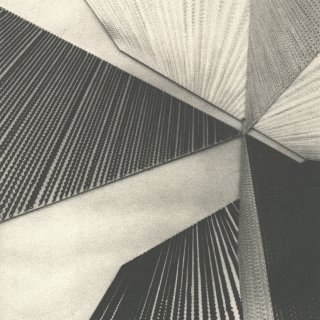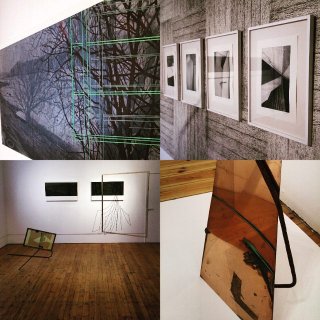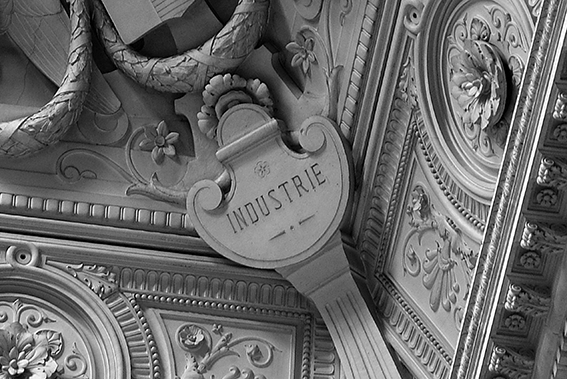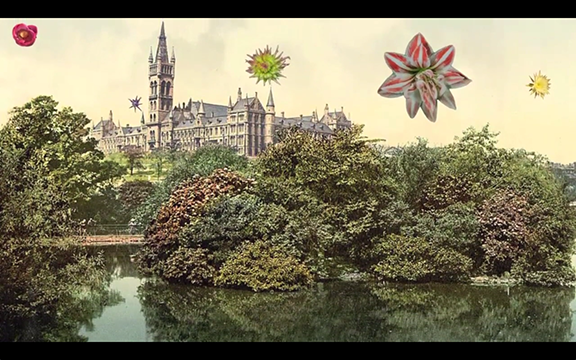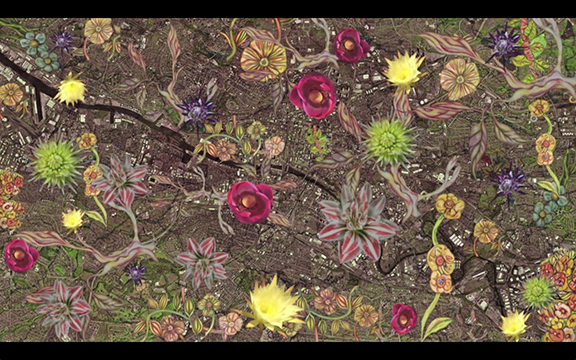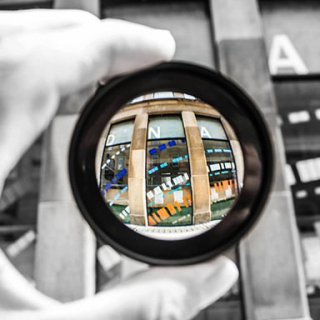Yasmin Ali
Urbanism // Design
Abstraction from Architecture
October 31st, 2015Abstraction from Architecture was an exhibition recently held at Edinburgh Printmakers. It was curated by the artist Bronwen Sleigh, known for the influence of architectural features within her work which was also featured within this exhibition. It also features the work of George Charman, Carla Scott Fullerton, and Andrew MacKenzie, all artists chosen by Sleigh for their focus on architecture.
Bronwen Sleigh's work features manmade places and forms, including architecture and a careful documentation process to translate the shapes to 2d prints and 3d drawings and sculptures. Her eye for architecture brought together these artworks and artists through careful curation.
MacKenzie's work features abstracted line drawings in bright pastelwork overlaid on traditional landscapes. Two paintings, one from Edinburgh University's collection and one from London, plus four pastel and gouache on paper drawings made bespoke for this exhibition including 2 lithographs made with EP assistant director Alastair Clark.
Sculptor Fullerton worked with Glasgow Print Studio to produce sculptures which playfully incorporated screens for screenprinting within the work, as well as moulded copper sculptures from etching and litho plates
Charman's work combines surface quality and the use of printmaker to abstract a surface, as well as understanding the role of the viewer's response to the environment. A featured piece includes a rubbing from a building from his neighbourhood estate, combined with a screenprint dusted with cement to produce a mesmerising pattern. A series of work in frames (pictured) explore the nature of interior space through collaged printed imagery of a striking installation featuring chains.
12 September - 24 October 2015
edinburghprintmakers.co.uk/exhibitions/Abstraction-from-Architecture
Abstraction from Architecture
Artists: George Charman, Carla Scott Fullerton, Andrew McKenzie and Bronwen Sleigh
Event Review: Beyond Borders Festival 2014, 23rd/24th August 2014
August 27th, 2014

This year I attended Beyond Borders International Festival of Literature and Thought, which has been running since 2010, previously known as Borders, Books and Bikes. The programme was packed with cycle tours, guided walks, author’s talks and political debates and discussions. A central theme has always been Peace and Conflict, and contested territories were discussed in several forums. The event is held in the grounds and within Traquair House, Scotland’s oldest continually inhabited house, a picturesque stately home near Peebles.
I was lucky to sit in on a dialogue with war photographer Paul Conroy’s lunchtime talk subtitled ‘Seeking Sanctuary’ about his British Red Cross exhibition of the same name. Here Paul described his photographic portraiture project documenting Syrian refugees seeking asylum in Scotland. Conroy told of the challenges of depicting people without showing their faces, in rooms with no real distinctive features, and the daunting task of portraying character in such surroundings. In Conroy’s words, he described it as more challenging than his war photography overseas. The photographs were also on display in the Exhibition tent and are on tour throughout the UK this year.
The following day, for the first talk we sought sanctuary in the chapel at Traquair House for a discussion with Feeding Frenzy author Paul McMahon, about the politics of food in the 21st century. McMahon was joined by Delfina Foundation director and Director of Visual Arts of Beyond Borders Scotland, Aaron Cezar, who presented slides of recent artwork on food politics from the Delfina Foundation for hungry eyes. Lawyer, author and academic Oscar Guardiola-Rivera led the discussion; and also chaired The Rule of Law discussion, which is an event common to many previous Beyond Borders’ Festivals. Sir Jeffrey Jowell QC of the Bingham Centre for the Rule of Law, the UN’s Andrew Gilmour, and David Marshall were on the panel to discuss what the rule of law means for today’s international policymakers, and how to sensitively – and modestly – intervene in international relations.
I found most provocative the discussion ‘Lifting the veil’, in particular, details of journalist and Iranian correspondent Ramita Navai’s book Tehran: City of Lies, which exposes details of contemporary urban life in Iran, including double-standards and deceptive appearances within society. Navai was able to infiltrate areas of Tehran invisible to many of its citizens and tell surprising stories which have been woven into narrative fiction. Also present was author and columnist Yasmin Alibhai-Brown positing the counter question regards the danger of Muslim women in the West reassuming the veil. The discussion was chaired and led by author Bonnie Greer OBE.
Beyond Borders events continue with its film festival in Edinburgh this week, and more events planned for 2015. For details of future events go to the website here.
// With Thanks to the Beyond Borders Team based in Edinburgh
ACT Symposium 2: Architecture and the Technological Revolution, 06.02.14
February 12th, 2014
As part of the architecture postgraduate course, Strathclyde University is running a series of symposia, and opening these up to the public as guests and architectural professionals as CPD events. The second in this series was themed around architecture and technological representation, and featured talks from two academics, Prof. Neil Spiller and Dr. Rachel Armstrong.
Neil Spiller is an academic and author based at The University of Greenwich. His work has a recurring theme of issues concerning digital media and architectural representation. He spoke of his longstanding interests in these areas, showing slides to illustrate his talk of key influences and many of his own drawings which blur the boundaries between the handmade, the mechanical and the digital. Key themes included Surrealism; metaphysics; psychogeography; modern art; modernism in general; collage; and concepts borrowed from digital media including Augmented Reality; cybernetics; cyberspace; hyperlinks; and the virtual world.
Spiller also introduced AVATAR, a group founded over 10 years ago at The Bartlett, UCL, along with its seven continuum of Space; Technology; Semiotics; Time; Psychogeography; Scope and Sensitivity. This led on to the introduction of his former colleague and the second speaker Dr. Rachel Armstong, who currently works for the unit. Armstrong has an interested background as a PhD architecture graduate via a biomedical sciences background. This gives her a unique set of skills and position of commentary on key issues, such as the quantification of sustainable outcomes.
After a brief introduction on the meaning and implications of the sustainability agenda, Armstrong set out a thesis that calls for the ontology of process as opposed to the hegemonic object-based philosophy generally pursued in architecture. In addition she cites biomimicry as a suitable tactic to emulate and introduced a series of films of experiments documenting life-like synthetic processes, such as the immiscibility of oil and water, a modern documentation of an experiment originally conducted in the late-eighteenth century. This work was reminiscent of video artist Robert Smithson’s work on entropy, which has been cited by architectural commentators as architecture’s ‘thermodynamic turn’.
Armstrong also introduced the pioneering project ‘Future Venice’, conducted in-situ with a team including Spiller, to use simulated technologies to recreate and reconstruct limestone in Venice’s waterways, to reinforce its foundation systems. She spoke of ‘programmable droplets’, which could ideally respond to changing conditions and assimilate to the marine ecology without further configuration. Citing the evolution of geotherms to angiotherms – or leafy to flowering plants – as a response to carbon fixation needs, Armstrong is hopeful for not only simulated life but evolution to future needs.
// This is the second part of a series of four symposia running weekly until and including the 27th February, except the 13th
Future Venice - here
Aerostatic Bloomage: a bold vision for The Commonwealth Games 2014
November 6th, 2013Aerostatic Bloomage is an aerial art and urban design project proposed to form a floral skyscape composed of 75 aerostats over the Commonwealth Games in Glasgow in 2014, by art and architect brothers Adrian and Dorian Wiszniewski. Adrian Wizniewski is a renowned artist and alumnus of Glasgow School of Art whose work has been exhibited globally including the Tate and MoMA New York. Dorian Wizsniewski is an architect and academic who leads postgraduate architecture degree programmes at the newly-merged Edinburgh School of Architecture and Landscape Architecture (ESALA), as well as running his own acclaimed practice.
As a concept, aerostatic bloomage received critical acclaim and interest, which has been piqued by the involvement of kickstarter funding and associated development led by ARCH*e, with the support of the project’s authors. ARCH*e is an Edinburgh-based participatory design collective David Clark and Ross McArthur who have continued to project to form a concept film and funding campaign to launch an community-based aerostat to engage with local residents.
There also may be the potential to repeat the concept and devise small-scale interventions around the city and around Scotland, using the skyscape as a stage to celebrate the games ceremonially.
DNA Hub: Crowdfunding for Glasgow's Creative Community
October 30th, 2013
Glasgow’s creative scene has been on the rise for many years now, and is starting to be celebrated in the mainstream, with innovations like the MAKlab facility recently featured on Glasgow City Council’s ‘People Make Glasgow’ tourism campaign. A new community creative hub DNA, led by Darren Kavanagh, is revitalising an empty central retail unit in Glasgow’s Style Quarter that has been vacant since the late 90’s. Just off George Square, 12-16 Frederick Street is the home for pop-up shop and arts venue DNA. DNA will offer affordable display, retail and studio space for creative start-ups to exhibit and sell their work and run events. An artisan café is also planned as a welcoming frontage for the community.
DNA is engaging with the architectural community, and has hosted an exhibition by architectural research and design collective Lateral North. During the exhibition the collective held well-attended free design consultations for prospective clients and tutorials for Masters students. Next month, entries from the recent Glasgow Institute of Architects’ design competition will be displayed at an exhibition at the venue, with shortlisted entrants invited to present at the opening night on the 13th November.
Though yet completely renovated, in its first few months so far DNA has hosted over 200 events including art exhibitions, charity projects, fashion shows and pop-up events. The response from the creative community and the general public has been strong, with over 9000 visitors and a growing crowd-funding campaign currently online. The campaign aims to raise £10,000 to help finance the growth plans, and there are incentives including free shop and exhibition space, discounts, and marketing plans. A party is planned for the 30th November for all contributors. Kavanagh says “Contributing to this campaign will mean the world to not just us at DNA but the many people who use our spaces on a daily basis”.
--
Online campaign - http://www.indiegogo.com/projects/dna-glasgow-multi-use-community-hub
Connect with DNA on Facebook - https://www.facebook.com/DNAGLASGOW
// DNA Hub, 12-16 South Frederick Street, Glasgow G1 1HJ
// Glasgow Institute of Architects exhibition “Connecting The Seven Lochs”, opens Wednesday 13th November at DNA, and runs until 20th November.


